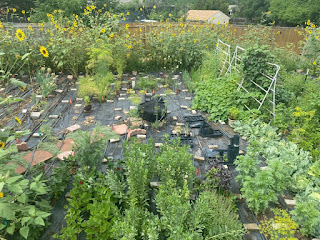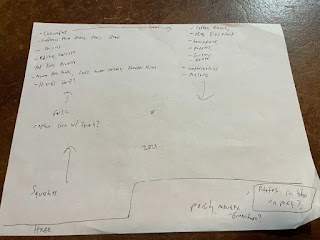"Gardening simply does not allow one to be mentally old, because too many hopes and dreams are yet to be realized." -Allan Armitage
 |
| Aerial View of the Urban Farm - July 2020 |
More planning of course! Mark at Ollin Farms refers to January as the farmers time to dream! Despite the fact that it's now February, it still holds true. I'm also inadvertently getting you used to farming life by not having anything go according to schedule and posting these how-to posts late, in which case you just have to adapt.
More Planning??? What? But we already have a rough plan? What more planning could you possibly want from us?
Indeed, you do have a rough plan but now we need a more in-depth and specific plan for where everything is going to go in your snazzy urban farm or garden! This is fairly simple in theory but the more you think about it the more complex it starts getting. In simple terms you just make a copy of your rough plan from before, then write down what you are going to plant where!
Quite simple, right?!
Keep in mind that plants are a lot like humans in a lot of ways. Some plants don't like each other and will fight each other if you put them next to each other. Likewise, other plants LOVE to be close to each other and benefit each other if you plant them close to each other. This is the beautiful wide world of companion planting.
Obviously you want to avoid putting the plants close together that don't like each other and you want the plants that benefit each other to be cozy neighbors. However, since this is an urban farm in the backyard of your house, you don't have acres of land and space is limited. This is where it gets fun and your creativity can shine to come up with different ways of growing plants to not only maximize your space but to have the plants benefit each other and give you greater yields.
For example, squash with long vines will climb up trellises and arches, so you can maximize space by growing squash vertically, which will also make for quite a neat look and Instagram worthy photos as not a lot of people are used to seeing that. These types of tricks you'll learn over time, as you grow your veggies year after year you'll get to know the different types of plants, what they like and don't like, odd behaviors, etc. It certainly sounds pretty dang crazy, but just wait, you'll see what I mean.
You can also learn that type of stuff by reading books, utilizing Professor Google and educating yourself. This is also how you can educate yourself about companion planting. There are vast amounts of resources for this and it gets incredibly complex once you start learning about it. I'm certainly still in the beginning stages of my companion planting education so I'm not going to dive into it too much at the moment. As you look at what veggies you're wanting to grow, look them up and see what plants they like and don't like, then form your plan from there. The Famers Almanac website has a good beginning companion planting guide that they update regularly.
With your limited backyard space it's likely not going to be 100% possible to only have plants that benefit each other next to each other, you're bound to have at least a few instances of plants that don't necessarily like each other be closer to each other than you would like. It is what it is and use this as a learning tool and observe how they interact with each other. Maybe plant a single test plant, elsewhere in the garden next to a more beneficial plant and compare how the two grow! This is how you learn, just go for it.
You also want your early spring crops to be grouped in the same general area (radishes, lettuces, winter greens, arugula, etc.) then once they are done (probably early to mid summer) you can plant fall crops in the same space (think pumpkins). If you want to use row coverings (either now or in the future) to protect the spring / fall crops from the snow, you want these plants to be close to each other.
You just write down on your map of your yard, exactly where you want everything to go so when it comes time to plant, you just whip out the map and follow the map.
Here's my extremely crude map of where I think everything is going:
 |
| Detailed yet crude map of where I'm planting everything in 2021 |
You likely can't read my handwriting so here is everything typed out, starting in the bottom left hand corner then going up the left hand side and around to the right side then back down towards the bottom:
-Squashes
-Replace Corn w/ Squash? (this is likely going to happen)
-Garlic (Orach and lettuce will likely be planted with the garlic)
-Herbs
-Mizuna Beni Hushi, Landis Winter Lettuce, Bloomsdale Spinach (early spring crop)
-Red Kale, Arugula (early spring crop)
-Radishes, Carrots
-Onions
-Soybeans, Fava Beans, Peas, Beans (some will be on pvc trellises)
-Cucumbers (on pvc trellises)
(over to top right hand corner of map now)
-Cabbage, Broccoli
-Okra, Eggplant
-Tomatoes,
-Peppers
-Greens
-Beets
-Watermelons
-Melons
(I'm likely going to be trying something new with potatoes, growing them in bags on the porch to continue the never ending space utilization experiments)
Marigolds are going to be planted sporadically throughout the entire urban farm to help keep pests away (pests generally don't like plants that have strong odors). I'm also going to be trying to get some various berry bushes established too along with a second strawberry patch.
Despite the fact that I have it written down where everything is going to go, this will likely change once I start planting depending on how many seedlings I have, etc. It's inevitable.
Comment below on how your urban farm plan is coming along. What questions do you have? What do you need more clarification on? How are you feeling about it?
No comments:
Post a Comment